Although GWP has been rising, the UK home insurance market is showing signs of fragile foundations, with falling policy numbers, rising claims costs and low consumer confidence putting sustained pressure on profitability
Recent growth in gross written premiums (GWP) across the UK home market may be masking a gap in the sector, according to a new report from Oxbow Partners.

The firm’s Home Report 2025 revealed that the majority of GWP growth seen between 2021 and 2023 had been driven by policy price increases, while the number of policies sold has shrunk by 3.5% over the same period to 20.8 million.
Moreover, the fall in penetration runs contrary to the trend in UK home building, which has seen new homes added to the market at a compound annual growth rate of 0.96% since 2011.
The market shrinkage has additionally caused profitability pressures for insurers as increased levels of competition for customers drive down revenue, an issue exacerbated by claims inflation.
Indeed, the report found that the house insurance market has become largely unprofitable, seeing a combined operating ratio (COR) below 100% just three times between 2016 and 2025.
Oxbow identified the sector’s loss ratio as the key driver of losses, growing from 46% in 2016 to 61% in 2023, while expense ratio declined slightly from 51% to 42% over the same period.
Consumer perceptions
The falling penetration rate may be attributable, in part, to a perceived lower quality of cover compared to other similar lines.
Read: Motor insurance switching reaches historic low – are GIPP rules finally making an impact?
Read: Ogden rate change causes overcompensation concerns for insurers
Explore more data-driven content here, or discover other news stories here
In 2023 – the latest year with complete data – the claims acceptance rate for buildings insurance stood at just 63%, while contents insurance stood at 77% and combined policies at 72% – well below the 99% acceptance rate in the motor insurance industry.
Likewise, the complaints rate in the sector was, at large, worse than the motor insurance industry. Buildings insurance (14%) and combined insurance (10%) both saw higher complaints levels than motor (7%). Of the home-related policies, only pure contents cover saw fewer complaints, at 6% across 2023.
The report explained: “Assuming home insurance customers are not inherently more fraudulent than motor customers – as most of them are the same people – this suggests that within home insurance there is a bigger gap between the perceived cover and the actual cover received for a lot of customers. This perception gap needs to be reduced to build trust in the market.”
Given the current challenges in the market, the report forecast that the sector would remain unprofitable across 2025, with high levels of subsidence claims, inflation and flat policy growth all contributing to weaker returns.
However, insurers and brokers may take comfort that a return to profitability was forecast for 2026, attributable to rate increases and an overall expense ratio improvement due to “market consolidation and ongoing efficiency efforts”.

He graduated in 2017 from the University of Manchester with a degree in Geology. He spent the first part of his career working in consulting and tech, spending time at Citibank as a data analyst, before working as an analytics engineer with clients in the retail, technology, manufacturing and financial services sectors.View full Profile
Hosted by comedian and actor Tom Allen, 34 Gold, 23 Silver and 22 Bronze awards were handed out across an amazing 34 categories recognising brilliance and innovation right across the breadth of UK general insurance.























































No comments yet